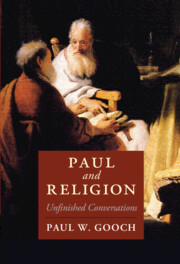Book contents
- Paul and Religion
- Cambridge Studies in Religion, Philosophy, and Society
- Paul and Religion
- Copyright page
- Dedication
- Contents
- Preface
- 1 What Does Paul Have to Do with Religion?
- 2 What Kind of Religious Interlocutor Is Paul?
- 3 What Is the Religious Form of Life for Paul?
- 4 What Does the Pauline Religious Form of Life Have to Do with Death?
- 5 What, for Paul, Is the Nature of the Religious Form of Community?
- 6 How, for Paul, Should Life ‘in Christ’ Be Lived?
- 7 What, for Paul, Are the Marks of Membership?
- 8 How, for Paul, Does a Religious Community Relate to Others?
- 9 Paul and Religion
- Select Bibliography
- Locorum Index
- Subject Index
3 - What Is the Religious Form of Life for Paul?
Going Wrong and Getting Right
Published online by Cambridge University Press: 31 March 2022
- Paul and Religion
- Cambridge Studies in Religion, Philosophy, and Society
- Paul and Religion
- Copyright page
- Dedication
- Contents
- Preface
- 1 What Does Paul Have to Do with Religion?
- 2 What Kind of Religious Interlocutor Is Paul?
- 3 What Is the Religious Form of Life for Paul?
- 4 What Does the Pauline Religious Form of Life Have to Do with Death?
- 5 What, for Paul, Is the Nature of the Religious Form of Community?
- 6 How, for Paul, Should Life ‘in Christ’ Be Lived?
- 7 What, for Paul, Are the Marks of Membership?
- 8 How, for Paul, Does a Religious Community Relate to Others?
- 9 Paul and Religion
- Select Bibliography
- Locorum Index
- Subject Index
Summary
Chapter 1 set out some characteristics of the religious form of life in an account designed to guide our discussion rather than to provide a comprehensive theory. The stance on the world of this form of life involves an attitude towards the divine of ontological humility and inadequacy. The acknowledgement of what it is to be the kinds of beings we are in relation to the divine also recognizes that things are not the way they should be with us. We need to get them right.
- Type
- Chapter
- Information
- Paul and ReligionUnfinished Conversations, pp. 44 - 63Publisher: Cambridge University PressPrint publication year: 2022

